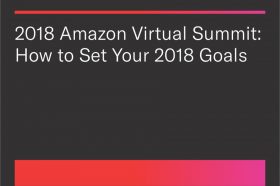Resources - Blog
How to Set Your 2018 Goals and Smash Them

Stay on top of the latest e-commerce and marketplace trends.
Due to the fact that many online sellers get caught up in the hustle bustle of the Q4 holiday season, they frequently don’t give enough attention to their business when transitioning to the new year, which can set their entire selling rhythm off track for the first quarter.
As part of a three-day webinar series alongside CPC Strategy and eComEngine, Feedvisor’s specific webinar session of the 2018 Amazon Virtual Summit really honed in and concentrated on fully-detailed, step-by-step goal-setting strategies to set your business up for success on Amazon.
Utilizing the example of OMG Electronics as a use case throughout the webinar, Feedvisor’s eCommerce experts Lotem Alon and Aaron Ellis demonstrated both the importance of understanding where a business came from and exists currently in order to discuss the future, as well as of establishing an overarching goal to adhere to throughout the year. For OMG Electronics, this was to increase total profit by 20%. The steps that follow all circle back to the main goal.
Start with a planning framework
- Why are you doing this? What is your intent?
- What do you want to achieve? What are your goals?
- How do you get there?
Then, it’s important for sellers to drill down into each level of the framework. For the intention piece above, the use case example included answers such as focusing on high-moving, profitable items, enlarging the offering of new items, and reducing shipping costs, as you need to be cost-effective in order to be profitable.
It’s crucial for sellers to remember that you need to maintain some capacity in your business – it won’t help you to have a laundry list of reasons behind your intention, as that would derail focus from other aspects of your business. You will want to focus on a handful of tasks to execute effectively and be able to be self-aware enough to understand your business’s bandwidth and breaking point.
Staying with the example of optimizing your product portfolio by focusing on high-moving, profitable items, it’s important to set SMART goals (specific, measurable, achievable, realistic, and timely). This will help you reign in any overly lofty goals, weigh if it’s in your power to accomplish it, inform you if it’s realistic to achieve, and help you stick to a timeline of when you want to achieve it. Each initiative that sellers dial in to should have its own timeline, owner, and resources.
Outline initiatives and set up processes to help you achieve your goals
1. Regularly replenish your profitable items.
It’s important to review your replenishment plan frequently and know your lead times. You should review your inventory levels on a weekly basis for your top 20% selling products. This is especially vital when it comes to calling out any declines or shifts in sales – it’s necessary to constantly reassess your line and make sure that your assortment’s selling patterns are status quo. Estimate your remaining days of coverage based on the last seven days’ velocity and be sure to refer back to your replenishment structure more often during promotions and holiday periods.
2. Identify pricing opportunities to increase profits.
It’s important to isolate key items and squeeze profits out of them wherever possible. Raising your margins will slow down your sales velocity.
3. Regularly review slow-moving, unpopular items and liquidate them.
This issue plagues sellers frequently, particularly those who sell via FBA. It’s more important than ever to understand your cadence of bringing new items in and disposing of stale inventory. The purpose of this is to get rid of dead product in order to free up cash flow for reinvestment, as well as lower your FBA and in-house storage fees. Our Amazon experts recommend that you develop a bi-weekly liquidation system and set timelines for each SKU that is going to be liquidated.
4. Invest in advertising to encourage sales of items with high profit margins.
Capitalizing on advertising can open the door for sellers to be able to analyze their campaigns’ and keywords’ impacts on their business’s bottom line over time.
Prioritize based on impact vs. effort
With so much at stake, it can be difficult for sellers to properly prioritize their efforts. For example, with a venture that calls for low effort but drives high value, the seller should jump on the opportunity right away. Other situations will require more planning and will need to be broken down step by step.
It’s essential to prioritize according to variables that are specific to your business goals and targets: urgency, impact, financial investment, duration, and effort. You should review your progress against your targets on a bi-monthly basis and adjust your plan wherever needed. At Feedvisor, we can help you keep tabs on this plan by fueling your growth through big data and smart decision-making.
To listen to the full 2018 Amazon Virtual Summit: How to Set Your 2018 Goals and Smash Them webinar, click the link below.



